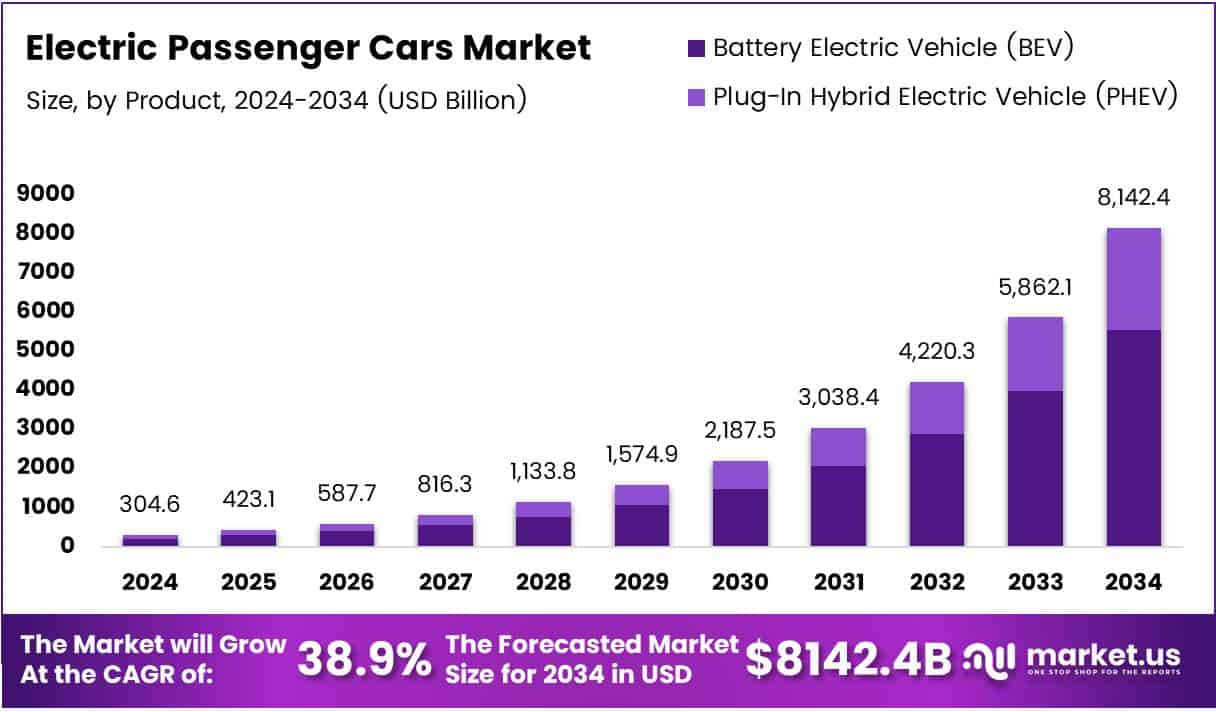Table of Contents
Market Overview
The Global Electric Passenger Cars Market size is expected to be worth around USD 8142.4 Billion by 2034, from USD 304.6 Billion in 2024, growing at a CAGR of 38.9% during the forecast period.

Huge opportunities exist. Emerging markets adopt EVs quickly. Low running cost attracts mass buyers. EV fleets and ride-sharing boost demand. Affordable models expand user base. Component makers enter the EV supply chain. Firms investing in local production gain more.
Governments support EV growth. Policies offer subsidies and tax relief. The U.S. and EU commit billions to EV adoption. India’s FAME II and China’s NEV push local growth. Public and private charging networks expand fast.
Emission rules are getting strict. Euro 7 and CAFE force automakers to shift. Non-compliance leads to fines and bans. Green mandates make EV adoption essential. Brands must align with climate goals. Electrification is now a must, not an option.
Key Takeaways
- Global electric passenger cars market to hit USD 8142.4 Billion by 2034.
- Market valued at USD 304.6 Billion in 2024.
- CAGR expected at 38.9% from 2025 to 2034.
- BEVs held 52.6% share in 2024 by product.
- Compact SUVs led vehicle type segment in 2024.
- Asia Pacific dominated with 45.2% share in 2024.
- Regional value stood at USD 137.1 Billion in 2024.
Market Drivers
Government subsidies help reduce EV costs. Tax benefits and incentives boost adoption. New laws support zero-emission vehicles. Cities aim to cut traffic pollution.
Battery technology is improving fast. EVs now offer better range and speed. Charging time is also getting shorter. Falling battery prices help make EVs cheaper.
Electric cars are low on maintenance. No fuel costs and fewer parts mean savings. People are choosing EVs to cut long-term costs.
Market Restraints
EVs still cost more upfront. Many buyers find them expensive. Charging networks are limited in some regions. Long trips need better charging access.
Battery life and disposal are concerns. Recycling systems are still growing. Charging times are longer than fuel refills. That may discourage new users.
Market Opportunities
Emerging markets have big growth potential. Countries like India and Brazil are investing in EVs. Cities are adopting electric taxi fleets. EVs suit urban transport needs well.
More fast-charging stations are coming. Smart charging and solar-powered stations are expanding. Battery leasing models make EVs more affordable.
Tech firms and automakers are partnering. Joint ventures speed up innovation and rollout. Digital tools, AI, and automation boost EV efficiency.
Market Trends
EVs are becoming smarter. Features include AI, over-the-air updates, and autonomous driving. Apps control car functions remotely. Consumers enjoy tech-rich driving experiences.
Subscription-based EV ownership is rising. Monthly plans and leasing are popular. Consumers avoid large upfront payments.
Startups enter with fresh ideas. Some offer direct-to-home test drives. Digital-first buying options attract Gen Z and millennials.
Luxury EVs now dominate headlines. Brands like Tesla, BMW, and Audi lead in design and performance. Fast EVs compete with sports cars.
Market Segmentation
Product Analysis
BEVs lead with 52.6% share in 2024. Zero emissions. Low cost. Govt support helps. Better batteries. More chargers. PHEVs rising. Dual power. Good for low charger zones.
Vehicle Type Analysis
Compact SUVs lead in 2024. Loved for space, comfort. Great for families. Hatchbacks suit cities. Sedans give performance. Big SUVs grow slow. Compact SUVs stay top pick.
Regional Insights
Asia Pacific
Asia Pacific leads with 45.2% market share. Valued at USD 137.1 billion. Growth driven by EV policies, subsidies, and strong infrastructure. China, Japan, and South Korea lead the region.
Europe
Europe ranks second. Strict emission laws push EV sales. Tax benefits and charging stations help adoption. Top countries include Germany and Norway.
North America
North America shows steady growth. The U.S. leads the region. EV demand rises with fuel prices and tech upgrades. Government support boosts sales.
Middle East & Africa
Adoption grows slowly. UAE and Saudi Arabia invest in EVs. High costs and weak infrastructure limit growth.
Latin America
Latin America is emerging. Growth from green transport plans. EV demand rises in urban areas. Early stage but strong future.
Competitive Landscape
Top car brands lead the EV race. Tesla dominates the global EV scene. Toyota, Hyundai, and Volkswagen expand electric lineups. Chinese brands like BYD and NIO are growing fast.
Companies invest in R&D for better batteries. Fast charging and long range are top goals. Automakers are setting up battery plants and EV factories.
Mergers and partnerships are common. Firms work together to share tech and reduce costs. Startups focus on smart features and unique models.
New business models help growth. Battery swapping, ride-sharing EVs, and solar charging are gaining traction. EV makers offer mobile services and online sales.
Future Outlook
The electric passenger cars market will keep growing. Falling battery prices will lower EV costs. More charging stations will improve user confidence.
Autonomous EVs will change driving forever. Solid-state batteries may offer faster charging and longer range. Government support remains strong.
More cities may ban fuel cars soon. EV policies will become stricter. Automakers are phasing out fuel cars gradually.
The future is electric. Smart, clean, and affordable. Companies that innovate fast will lead.
Recent Developments
April 8, 2025 – EV sales hit 7.6% of new passenger cars in Minnesota in 2024. Demand grew from incentives, awareness, and charging stations. EV adoption in the state continues rising. Minnesota shows strong shift toward clean mobility.
June 11, 2025 – General Motors will invest $4 billion in U.S. plants by 2027. This aims to boost gas and EV production. GM plans to meet rising EV demand. The move supports growth and green transition.
Conclusion
The electric passenger cars market is expanding rapidly. Supportive policies, tech upgrades, and rising eco-awareness drive growth. Falling costs and better infrastructure will boost adoption. As demand rises, EVs will become the new normal in global transport.
Discuss your needs with our analyst
Please share your requirements with more details so our analyst can check if they can solve your problem(s)



